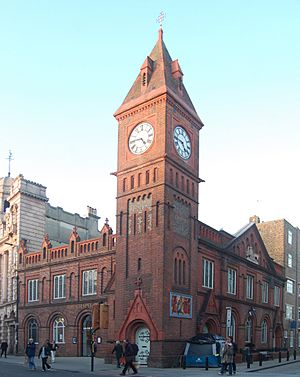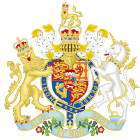Chapel Royal, Brighton facts for kids
Quick facts for kids Chapel Royal, Brighton |
|
|---|---|
 |
|
| 50°49′21″N 0°08′22″W / 50.8226°N 0.1394°W | |
| Denomination | Church of England |
| Website | www.chapelroyalbrighton.org.uk |
| Administration | |
| Parish | Brighton, St Peter with the Chapel Royal |
| Deanery | Rural Deanery of Brighton |
| Archdeaconry | Chichester |
| Diocese | Chichester |
| Province | Canterbury |
The Chapel Royal is an old church in the middle of Brighton, a city in England. It was built in the 1700s as a "chapel of ease." This means it was a smaller church built to help a main parish church that was too far away or too crowded.
Over time, the Chapel Royal became one of Brighton's most important churches. It even got its own parish, which is like its own church district. It was also very popular with the Prince Regent and the fashionable people of the Regency era. Today, it is still an active church.
Contents
A Look Back: The Chapel's History
Brighton's Rise to Popularity
In the 1700s, Brighton was a small town. Its main business was fishing, and it was still recovering from a big storm in 1703. Only about 2,000 people lived there.
Things started to change when a doctor named Richard Russell from nearby Lewes suggested that bathing in and drinking seawater could help people get well. He said Brighton was a great place for this. Soon, many people came to Brighton for this new health trend. This made the town a popular place to visit.
The Prince Regent's Influence
Brighton became even more popular when the Prince Regent first visited in 1783. He was the son of King George III. By 1786, he had a home in Brighton. Later, he had a grand palace, the Royal Pavilion, built there.
The Prince didn't go to church very often. Brighton's only main church, St Nicholas, was far from his home and up a steep hill. Also, with more visitors coming to Brighton, St Nicholas Church became very crowded.
In 1789, the new Vicar of Brighton, Revd Thomas Hudson, decided to build a new chapel. He wanted it to be closer to the Prince's home. He hoped this would encourage the Prince to attend church more often. A new, central chapel would also help with the overcrowding at St Nicholas Church.
Building the Chapel Royal
The Prince Regent liked the idea. He agreed to rent a special seat, called a pew, and even helped lay the first stone. This ceremony happened on November 25, 1793. The chapel was built at the corner of North Street and a new street called Prince's Place.
Construction took about a year. The Prince and his wife, Caroline of Brunswick, attended the very first service on August 3, 1795.
| Brighton Chapel of Ease Act 1803 | |
|---|---|
| Act of Parliament | |

|
|
| Long title | An Act to establish a Chapel of Ease at Brighthelmston in the County of Sussex. |
| Citation | 43 Geo. 3. c. xci |
| Dates | |
| Royal assent | 24 June 1803 |
| Text of statute as originally enacted | |
At first, Revd Hudson owned and managed the chapel himself. He only opened it when Brighton was busiest. In 1803, it officially became a "chapel of ease" for St Nicholas Church. This happened because he got a special law passed, called the Brighton Chapel of Ease Act 1803.
This law allowed the Vicar of Brighton to hire a special priest, called a perpetual curate, for the chapel. The priest's salary was paid by renting out most of the pews. Only 224 seats had to be free. Visitors who didn't rent a pew could pay a small fee to get in. In return, the priest had to pay for a clerk, the bread and wine for Communion, and the building's upkeep.
Changes and Famous Visitors
Soon after becoming an official chapel of ease, the Chapel Royal was formally blessed by the Bishop of Chichester on August 16, 1803. However, by this time, the Prince Regent no longer worshipped there often. He stopped coming after a sermon, which was supposedly about bad behavior, offended him.
Even so, other members of the Royal Family visited the chapel sometimes. The last recorded visit by a royal was in 1840, by Princess Augusta Sophia, the Prince Regent's sister. Later in the 1800s, two future British prime ministers regularly attended the chapel. William Ewart Gladstone came whenever he visited Brighton. Winston Churchill attended between 1883 and 1885 when he was a student at a local school.
Becoming a City Church
The chapel's ownership changed hands several times. In 1834, Revd Thomas Trocke became the perpetual curate. He stayed until 1875. During his time, in 1873, the chapel got its own district for the first time as Brighton's church areas were reorganized.
The building was closed for eight months in 1876 and 1877 for repairs and changes inside. An architect named Arthur Blomfield oversaw this work. Later, in 1880, some houses were torn down, revealing the chapel's south side for the first time. Until then, only the east side could be seen. Blomfield designed a new outside look, including a tower. This work was done in two parts, finishing in 1896.
In 1896, the chapel officially became a full parish church. However, fewer people lived in central Brighton by then, as the area became more about shops and businesses. The local population became so low that in 1978, the Chapel Royal's parish joined with St Peter's Church.
The Chapel Royal became a separate parish again in July 2009. Services became less frequent for a while, and part of the chapel was even turned into a Christian bookshop. But when the nearby Holy Trinity Church closed in 1984, its members started coming to the Chapel Royal. This led to more regular services. In 1995, the church was changed inside to become a "city church." This means it serves the whole community, not just people living in one small area.
The Chapel's Design
Original Look and Early Changes
The first chapel was built in a Classical style. It had a smooth, stucco finish. It featured round sash windows and a triangular top part called a pediment, which had the Prince's coat of arms. The entrance was framed by Doric columns.
Inside, there were balconies, called galleries, on each wall. These were supported by decorated columns. The gallery above the altar held the organ, and there was a tall, fancy pulpit. During the changes in 1876–1877, the gallery above the altar was removed. A new area for the altar, called a chancel, was added. It was separated from the main seating area, the nave, by an iron screen. A new pulpit and a stand for reading, called a lectern, were also added.
Later Exterior Changes
The outside of the chapel was rebuilt in 1882–1883 (south side) and 1896 (east side). This happened because buildings next to the chapel were torn down to make North Street wider. The stucco was replaced with red brick. The pediment was made larger. The new south side looked similar to the east side, but it was not as tall or long and didn't have a pediment. In 1995, the entrance area was changed again, and more glass was added so people could see inside from the street.
The most important part of Arthur Blomfield's work on the outside was the tall, red-brick clock tower. It has some flint stones and a sloped slate roof. The tower has four clock faces, each set in a special clay tile called terracotta.
The Chapel Today
The main service at the Chapel Royal is held on Sundays at 10:00 AM. Other services happen on Wednesdays. The chapel has a long history of music. Concerts have been held there since the beginning and are still a regular event, usually on Tuesdays.
A coffee shop, run by church members for local charities, is open every Saturday. The building also hosts regular Alcoholics Anonymous meetings. This is part of the chapel's way of helping people in the city who are facing difficulties.
The chapel was given a special heritage protection status, called Grade II*, on July 30, 1992. This means it is a very important historic building. As of February 2001, it was one of 70 Grade II*-listed buildings in Brighton and Hove.
Keeping the Chapel Strong: Repairs
In 2012, important repairs were done to the outside of the chapel. Some bricks were becoming unsafe and falling, especially because of damage from freezing and thawing in the cold winter of 2009.
The work included replacing terracotta on the south side and tower. They also fixed areas of brickwork using a special lime mortar. Steel supports above windows were replaced, and a lightning conductor was installed to protect the building from lightning strikes. This repair project won an award, the King of Prussia Gold Medal, in 2012.
Gallery
Images for kids
-
The Holy Trinity Church was almost part of the Chapel Royal's parish. When it closed, its members moved to the Chapel Royal.
See also








